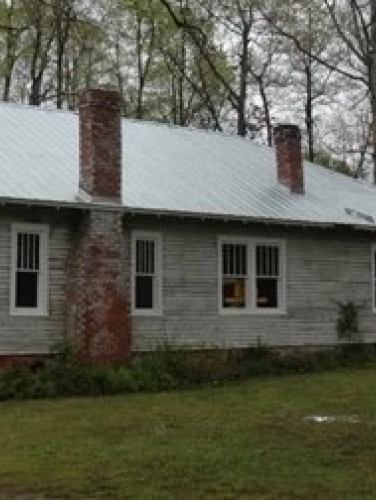
Lawing Farmhouse
(ca. 1924)
The Lawing Farmhouse offers a tangible reminder of the small rural farms that once dominated the Mecklenburg County landscape.
6100 Neck Rd, Huntersville, NC 28078
The Lawing family originally immigrated to the United States from Wales in the early 1700s. Harry Campbell Lawing (1899-1973) was the youngest of the six children born to James Lafayette Lawing and Margaret Jane Dunn Lawing, who wed in 1884. Harry’s grandfather, James Middleton Lawing, was the first member of the Lawing family to move to Mecklenburg County. Harry’s parents initially lived in the Paw Creek section of Mecklenburg County but moved to the Hopewell community in early 1909. The family settled and grew along Neck Road, not far from Beatties Ford Road and Hopewell Presbyterian Church. It has been reported that at one time, the Lawing family owned some 3,000 total acres stretching from Neck Road to State Highway 16 (Brookshire Boulevard), but their land holdings dropped considerably as the family grew and several family members moved away from the area.
Property Quick Links
As adults, Harry and at least three of his siblings lived along Neck Road, with Harry’s house located on a parcel of family land situated between the homes of his brother John Blair Lawing and his sisters Ada Dunn and Violet Isabella Lawing. Harry enlisted his cousin Frank Lawing to build the house for him around 1924. The Lawing Farmhouse was one of several similarly styled houses built by Frank in the Derita community. Like many other residents in the area, Harry maintained a small farm, raising corn and cultivating about fifteen acres of cotton. He raised pigs for meat and chickens for eggs that he would travel into Charlotte to sell. Harry also rented out some of the land that he did not farm to sharecroppers.
The Lawing Farmhouse offers a tangible reminder of the last prosperous years of Mecklenburg County’s once thriving agrarian economy. By the late 1920s and early 1930s, national and regional economic depressions ended both the era of southern dominance over cotton production and the autonomy of small independent cotton farmers. Mecklenburg County’s rural farmers faced many obstacles including poor soil, sick crops, and falling crop prices. As the twentieth century progressed and Charlotte expanded, those farmers found themselves under attack from land developers and suburban sprawl. As the municipal boundaries of Charlotte stretched further and further away from the city center, these small farms and the stories they held quickly and quietly disappeared, leaving only rare examples like the Lawing Farmhouse as evidence of a not-too-distant past.

